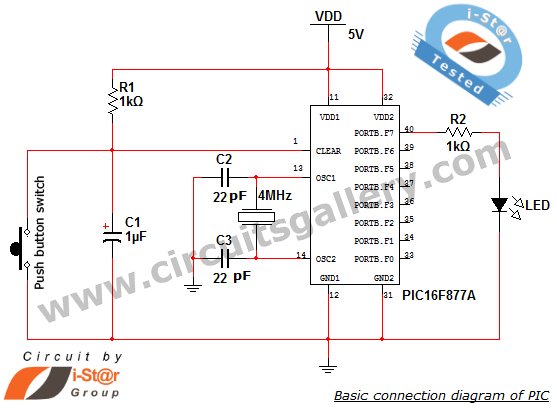Usually high level quiz competitions are very much time-oriented as it becomes significant to determine who has answered first. So here we’ll see how to make a buzzer system that helps to decide the winners.
Actually I designed this circuit of buzzer for quiz program conducted in our area and then I thought it may help someone, so I decided to introduce it here.
This game show buzzer circuit uses PIC16F877A and a LED matrix to display who has pressed the button first. As soon as someone hits the button first, all other buttons are disabled helping to find the person or group which are ready to answer the question.
Read:LED Interfacing with PIC Microcontroller: Embedded C program with circuit
A reset button provided for the quiz master enables all the switches again for the next question. The led matrix helps to display the number in larger size and it’s designed to blink continuously. Buzzer will be ON for a second when anyone presses the button.
Components required
- PIC16F877A
- LED matrix 8×8
- Transistor BC548
- Resistor (1K,10Kx7,220)
- Capacitor(33pfx2)
- Crystal (12 MHz)
- LED Green
- Buzzer 5V(PCB Type)
- Push button x7
Quiz buzzer schematic working
- LED matrix is connected through PORTB and PORTD of the microcontroller; cathode row is connected to PORTB and anode row is connected to PORTD.
- When the power is ON, green LED starts to glow indicating that all switches are ready to press and LED matrix in blanked by sending PORTD=11111111 AND PORTB=00000000.
- PIC microchip will continually scan the pins of PORTC to check if someone presses the button. It will check the next button only if the present button is not pressed.
- While programming I had chosen the ‘if’ statement so as to avoid activation of two buttons at the same time by checking each pin from 0 to 7 of PORTC. Probability of this occurring is very low (And I know it’s a little bit unfair if that happens). The use of ‘case’ statements will check all the pins at the same time which may lead to activation of two buttons at a time.
Note: You may also want to check out if-else statements in C programming.
- The pins of PORTC is connected to +5V (pull up) through a 10K resistor, so if no one pressed the button PORTC gets 11111111 as default.
- Pressing of any switch will make a short circuit to ground getting a logic zero at the corresponding pin of PORTC and so the program execution will enter into the sub function (loop) of the particular group number to display on the LED matrix.
- Here I interfaced LED matrix directly to the PIC micro controller which makes the circuit simpler.
- When the program execution enters in to any particular sub function(loop), it will enable the buzzer by sending a logic 1 to the 5th pin of PORTC and it send a logic 0 after 1 second (make beep sound of one second long).
- Then enters in to the matrix loop, which scans each column with delay of 3 milli second.
- PORTB sends the data corresponding to the column; higher scanning speed will make see the display as a number due to the persistence of vision of the eye.
- Upon pressing the reset button, program execution will return to the main program.
 Quiz buzzer program
Quiz buzzer program
The microcontroller code for this project is available at our Program Center.
I hope you like this quiz buzzer circuit diagram and let me know through the comment box below if you need any further assistance.
For more detail: Electronic Quiz Buzzer Circuit Diagram using PIC Microcontroller


